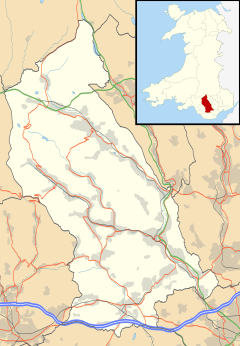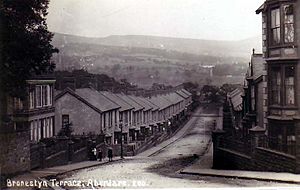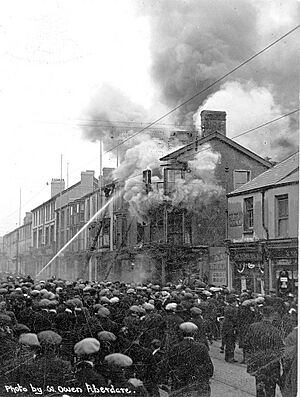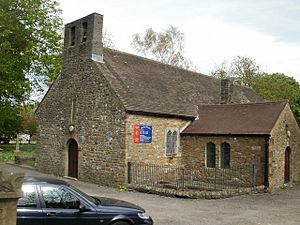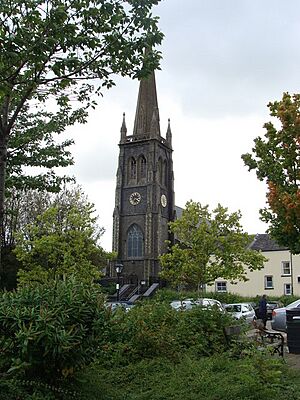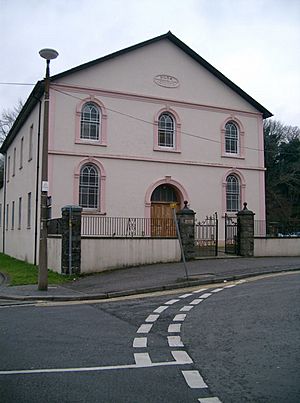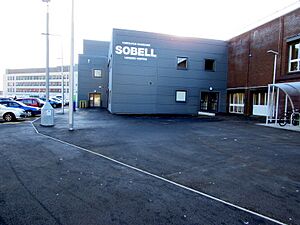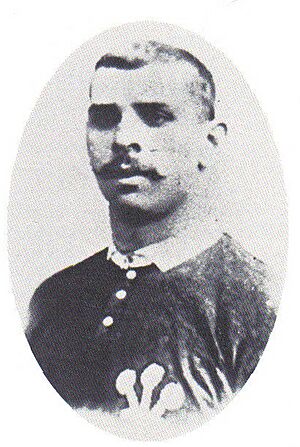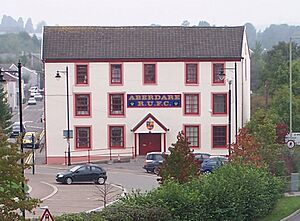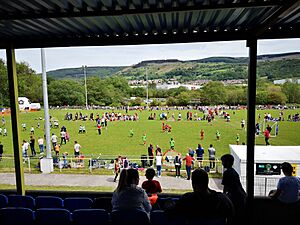Aberdare facts for kids
Quick facts for kids Aberdare
|
|
|---|---|
|
|
|
| Population | 39,550 (Mid-2017 Estimate) |
| OS grid reference | SO005025 |
| Principal area |
|
| Ceremonial county | |
| Country | Wales |
| Sovereign state | United Kingdom |
| Post town | ABERDARE |
| Postcode district | CF44 |
| Dialling code | 01685 |
| Police | South Wales |
| Fire | South Wales |
| Ambulance | Welsh |
| EU Parliament | Wales |
| UK Parliament |
|
| Welsh Assembly |
|
Aberdare (/ˌæbərˈdɛər/ ab-ər-DAIR; Welsh: Aberdâr) is a town in the Cynon Valley area of Rhondda Cynon Taf, Wales. It is located where the Rivers Dare (Dâr) and Cynon meet. Aberdare has about 39,550 people (as of mid-2017). The town is about 4 miles (6.4 km) southwest of Merthyr Tydfil. It is also about 20 miles (32 km) northwest of Cardiff and 22 miles (35 km) east-northeast of Swansea. In the 1800s, Aberdare grew into a busy industrial town. It was also known for its lively culture and as an important place for printing books.
Contents
What's in a Name?
The name Aberdare means "mouth of the river Dare". This is because the town is located where the Dare river (Welsh: Afon Dâr) joins the Cynon (Welsh: Afon Cynon). The Welsh spelling of the name follows formal rules. However, the English spelling shows how the name is said in the local Gwenhwyseg dialect.
Dâr is an old Welsh word for oak trees. The valley was famous for its large oak trees even in the 1800s. Long ago, the river might have been linked to Daron. This was an ancient Celtic goddess of oak. So, the town's name might share roots with Aberdaron and the Daron river. Like many Welsh place names, the area was likely known by this name long before the town grew.
A Look at Aberdare's Past
Aberdare began in the Middle Ages. It was first a small farming village. The Church of St John the Baptist, built around 1189, was at its center. By the mid-1400s, Aberdare had a water mill and small thatched cottages.
In the early 1800s, the town's population grew quickly. This was because of the large amounts of coal and iron ore found there. The number of people in the whole area increased tenfold in the first half of the 19th century.
Two main industries helped the town grow: first iron, then coal. A branch of the Glamorganshire Canal (built in 1811) was used to move these products. Later, trains became the main way to transport goods to the South Wales coast. From the 1870s, coal mining became the most important industry. There was also a small factory that made tinplate. Several brickworks and breweries also operated. By the late 1800s, the town became a pleasant place to live, even with the mines nearby.
Aberdare had many churches and chapels. Most of the chapel services were in Welsh. Most of these chapels have now closed. Many have been turned into other buildings. The town area includes what were once separate villages. These include Aberaman, Abernant, Cwmaman, Cwmbach, Cwmdare, Llwydcoed, Penywaun and Trecynon.
There are old stone piles called cairns. There are also remains of a circular British camp on the mountain between Aberdare and Merthyr Tydfil.
How Aberdare's Population Grew
In 1801, only 1,486 people lived in Aberdare. But the early 1800s saw fast industrial growth. This was first due to ironworks, then iron and steam coal industries. By the 1840s, the population was growing by 1,000 people each year. Most of these were workers moving from west Wales, where farming was struggling.
The population of the Aberdare area was 9,322 in 1841. It grew to 18,774 in 1851, and 37,487 in 1861. Even with a small drop in the 1870s, the population kept growing. The early 1900s saw a very sharp increase. This was mostly because of the steam coal trade, reaching 53,779 people in 1911. The population has since gone down. This is due to most of the heavy industries closing.
At the 2001 census, Aberdare had 31,705 people. By 2011, it was 29,748. This number includes people from nearby areas like Aberaman, Abercwmboi, Cwmbach and Llwydcoed.
Language in Aberdare
Welsh was the main language in Aberdare until the mid-1900s. Aberdare was also an important place for Welsh language publishing. Many early workers who moved to the area spoke Welsh. In 1851, only ten percent of the people were born outside Wales.
By 1901, the census showed that 71.5% of people in Aberdare spoke Welsh. This dropped to 65.2% in 1911. The 1911 data showed that older people spoke Welsh more than younger people. Women also spoke Welsh more than men. The language shift sped up after World War I. English slowly started to replace Welsh as the common language. This was seen by the decline of Welsh newspapers in the town. This trend continued after World War II. However, Welsh language schools, like Ysgol Gymraeg Aberdâr, were set up in the 1950s.
Aberdare's Industries
Iron Industry
Ironworks were built at Llwydcoed in 1799 and Abernant in 1800. Others followed at Gadlys in 1827 and Aberaman in 1847. The iron industry really started to grow around 1818. This was when the Crawshay family bought the Hirwaun ironworks.
The development of these ironworks helped Aberdare grow into a town. The iron industry was slowly replaced by coal mining. All five ironworks closed by 1875. This was because there wasn't enough local iron ore. Also, importing ore became cheaper after steel was invented.
Coal Industry
The iron industry did not have a huge impact on Aberdare's economy. In 1831, only a small part of the population worked in manufacturing. In the early days, most coal mined in Aberdare was coking coal. It was used locally, mainly in the ironworks.
In 1836, people started mining "Four-foot Seam" steam coal. This coal had a high calorific value. Many new mines were quickly dug. This coal was great for steam trains and steam ships. An export trade began, using the Taff Vale Railway and the port of Cardiff. The population grew very fast. In 1851, the Admiralty decided to use Welsh steam coal for Royal Navy ships. This made Aberdare's coal famous and started a huge international export market.
The growth of coal mining led to many worker disputes. Some were local, others affected the whole coalfield. Trade unions started appearing in the Aberdare Valley from the 1830s. The first big strike was the Aberdare Strike of 1857–8. This dispute showed a strong sense of unity among the miners.
Many big Welsh coal companies started in Aberdare. These included companies like Samuel Thomas, David Davies and Sons, Nixon's Navigation and Powell Duffryn.
In the early 1900s, miners in Aberdare became more active in protests. A large unofficial strike happened from 1910 to 1911. This strike got a lot of attention.
Like the rest of the South Wales coalfield, Aberdare's coal industry began to decline after World War I. The last two deep mines closed in the 1960s. Aberaman closed in 1962 and Fforchaman in 1965.
On May 11, 1919, a large fire broke out on Cardiff Street, Aberdare.
With the decline of both iron and coal, Aberdare now relies on businesses for jobs. Its industries include making cables, smokeless fuels, and tourism.
Aberdare's Culture
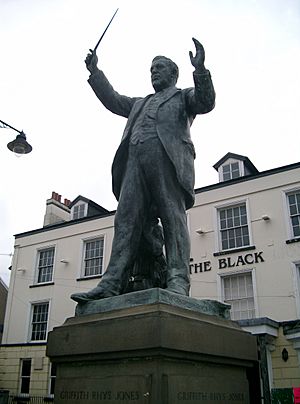
During its busiest years, Aberdare was seen as a center of Welsh culture. It hosted the first National Eisteddfod in 1861. This was a big Welsh festival of music and poetry. The town built a monument in the local park to remember this event. The Eisteddfod was held in Aberdare again in 1885 and in 1956 at Aberdare Park. The Gorsedd standing stones from the Eisteddfod are still there.
From the mid-1800s, Aberdare was an important publishing center. Many books and journals were printed there, mostly in Welsh. A newspaper called Y Gwladgarwr (the Patriot) was printed in Aberdare from 1856 to 1882. It was read widely across the South Wales valleys. From 1875, a more successful newspaper, Tarian y Gweithiwr (the Workman's Shield), was published. This newspaper strongly supported trade unions for miners and ironworkers. It closed in 1934.
The Coliseum Theatre is Aberdare's main arts venue. It has a 600-seat auditorium and a cinema. It is in nearby Trecynon and was built in 1938.
The Second World War poet Alun Lewis was born near Aberdare in Cwmaman. There is a plaque for him with a quote from his poem.
The rock band Stereophonics started with members from Cwmaman. The band Crass played their last live show for striking miners in Aberdare.
Griffith Rhys Jones, also known as Caradog, was a famous choir conductor. His 'Côr Mawr' ("great choir") had about 460 voices. They won first prize twice at competitions in London in the 1870s. His statue, made by Goscombe John, stands in Victoria Square.
Aberdare was culturally linked with the German town of Ravensburg.
Religion in Aberdare
Anglican Church
The first parish church, St John the Baptist, was built in 1189. Some of its original parts are still there.
As Aberdare grew, the old church became too small. John Griffith, the rector, raised money for a new church. St Elvan's Church was quickly built in the town center between 1851 and 1852. This Church in Wales church is still used today. It has a modern pipe organ.
John Griffith helped build other churches too. These include St Fagan's in Trecynon. Other churches are St Luke's (Cwmdare), St James's (Llwydcoed) and St Matthew's (Abernant).
In the Aberaman and Cwmaman area, there is St Margaret's Church. It has an old pipe organ. St Joseph's Church in Cwmaman has been updated to be more of a community center. Regular church services still happen there.
In 1910, there were 34 Anglican churches in Aberdare. A survey that year showed that 17.8% of people went to church services. The rest went to nonconformist chapels.
Nonconformity
The Aberdare Valley was a strong area for Nonconformity from the mid-1800s. Nonconformists were very active in Welsh politics and education. Thomas Price, a minister at Calfaria, Aberdare, was a key leader.
Aberdare was a major center of the 1904–05 Religious Revival. This revival caused some concern among ministers. It seemed to take attention away from preaching. The local newspaper, the Aberdare Leader, was suspicious of the revival. The revival had a big impact for a short time.
After the revival, the influence of the chapels slowly declined. This was due to several reasons. These included the rise of socialism and younger people speaking more English.
Many chapels are no longer used for worship. Some have been turned into homes or other buildings. Others have been torn down. Notable chapels included Calfaria, Aberdare and Seion, Cwmaman (Baptist). Also Saron, Aberaman and Siloa, Aberdare (Independent), and Bethania, Aberdare (Calvinistic Methodist).
Independents
The first Welsh Independent chapel in Aberdare was Ebenezer, Trecynon. By 1910, there were 35 Independent chapels. They had a total of 8,612 members. Siloa Chapel was the largest Independent chapel. It is one of the few that are still open today.
Baptists
The Baptists were the most influential nonconformist group in Aberdare. Their growth was led by Rev. Thomas Price. He came to Aberdare in the early 1840s as minister of Calfaria Chapel. By 1910, there were 30 Baptist chapels. They had a total of 7,422 members. Most of these chapels were started with Thomas Price's help. He encouraged members to open new chapels for people moving to the town.
Calvinistic Methodists
By 1910, there were 24 Calvinistic Methodist chapels in Aberdare. They had a total of 4,879 members. The most important was Bethania, Aberdare. It was once the largest chapel in Aberdare. It was torn down in 2015.
Other Groups
The Salvation Army started a mission in Aberdare in 1878. Mother Shepherd, a Welsh speaker, helped set up seven new stations.
The Wesleyan Methodists had 14 places of worship by 1910. There was also a strong Unitarian group in the valley. They had three places of worship by 1910. Highland Place Unitarian Church celebrated its 150th anniversary in 2010. It has a pipe organ that is used for services.
Judaism
Seymour Street once had a synagogue. It opened in the late 1800s but closed in 1957. The site now has a blue plaque to mark its history.
Education in Aberdare
Education was a concern in the early industrial period. The 1847 Education Reports highlighted problems. There was not enough space for children in schools. In Aberdare, there was room for only 1,317 children. This was a small part of the population.
As a result, the main nonconformist groups worked together. They opened a British School in 1848, known as Ysgol y Comin. It could hold 200 students.
The establishment of the Aberdare School Board in 1871 helped expand education. By 1889, the Board ran fourteen schools. However, children not attending school was still a problem.
Colleges
- Coleg y Cymoedd
Secondary Schools
- Aberdare Community School
- St. John the Baptist School (Aberdare)
- Ysgol Gyfun Rhydywaun
Getting Around Aberdare
The town has Aberdare railway station and Aberdare bus station. They are across from each other in the town center. The town also had a big improvement project in 2012–13.
Sports in Aberdare
Aberdare was known for its "summer games/dances" and "manly sports" since the 1640s. The town is home to Yr Ynys. This is a historic sports ground. It hosted the first Rugby League international match. It also had a professional Rugby League team and a football League side. Today, the Ynys hosts the town's Rugby union and cricket teams. It also has the Sobell Leisure Centre and the Ron Jones Athletics Stadium. This stadium has a track and field facilities.
Cricket
A cricket club was started again at the Ynys in 1968. It was first called Riverside Cricket Club. Later, it became Dare Valley CC, and then Aberdare CC. In 2008, the club got a long-term lease for land near the pitch. They built a clubhouse and training nets. Today, the club has 3 adult teams and 4 junior teams.
Rugby League
The Northern Union held the first international rugby league match at the Ynys on January 1, 1908. Wales played against the New Zealand All Golds. The local player, Dai "Tarw" Jones, scored the winning try. Wales won 9–8.
The match had 15,000 paying fans. This showed how popular rugby league could be. A Rugby League club, Aberdare RLFC, was started in Aberdare on July 21, 1908. On September 5, 1908, the new team played their first match against Wigan.
Aberdare struggled in the Rugby Football League. They finished last in their only season. On July 10, 1909, Aberdare left the Northern Rugby League due to money problems.
Rugby Union
A rugby club in Aberdare was recorded as early as 1876. But the modern Aberdare RFC started in 1890. The club was very successful in the early 1900s. Local star Dai 'Tarw' Jones was captain from 1905 to 1907. Jones was a key player when Wales beat the New Zealand All Blacks in the "Match of the century".
In 1907, Jones and the Aberdare club were involved in a professionalism scandal. The Welsh Rugby Union banned the club's committee and many players. This led many players and fans to switch to rugby league.
Despite the bans, rugby union continued. The club, renamed Aberaman RFC, moved to Aberaman Park. The Ynys Stadium hosted its first international rugby union side on December 12, 1935. The 1935-36 All Blacks played a tour match there.
Aberaman RFC returned to the Ynys in the 1960s. In 1971, a clubhouse opened. After rugby union became professional, the bans on Aberdare were lifted. The club took the name Aberdare RUFC again. Aberdare is also home to Abercwmboi RFC and Hirwaun RFC.
Association Football
The Ynys stadium was also home to Aberdare Athletic F.C.. They were part of the Football League from 1921 to 1927. Aberdare finished last in their final season. They closed in 1928 after failing to be re-elected to the league.
Aberaman Athletic F.C. played until World War II. They were followed by Aberdare & Aberaman Athletic in 1945 and Aberdare Town F.C. in 1947. The club still plays in the Welsh Football League. Today, Aberdare Town plays in the South Wales Alliance League at Aberaman Park.
Famous People from Aberdare
- See also Category:People from Aberdare
Arts and Entertainment
- Ioan Gruffudd – actor, born in Llwydcoed, Aberdare
- Griffith Rhys Jones – known as Caradog, famous choir conductor
- Alun Lewis – war poet
- Mihangel Morgan – Welsh language writer, often writes about Aberdare
- John Morgan – comedian
- Roy Noble – writer and broadcaster
- Ieuan Rhys – actor from Trecynon
- Rhian Samuel – composer and music professor
- Stereophonics – all three original members grew up in Cwmaman, Aberdare
- Jo Walton – fantasy novelist
Politicians and Public Figures
- Henry Austin Bruce – 1st Baron Aberdare & Home Secretary (1868–1873)
- Rose Davies – Labour politician and advocate for women's rights
- Patrick Hannan – political journalist and presenter
- Bethan Sayed – Member of the Senedd for South Wales West
Religion
- Thomas Price (Baptist minister) – Baptist Minister and active politician
Science
- Lyn Evans – particle physicist, led the Large Hadron Collider project
Sports Stars
- Jon Bryant – Wales rugby union player
- Les Cartwright – Wales football player
- Isaak Davies – football player
- Neil Davies – Wales rugby league player
- Amy Evans – Wales rugby union player
- Ian Evans – Wales and British & Irish Lions rugby union player
- David "Tarw" Jones – played rugby for both Wales rugby league and Wales rugby union
- Arthur Linton – cyclist
- Jimmy Michael – world cycling champion
- 'Big' Jim Mills – Wales & Great Britain rugby league player
- Teddy Morgan – Wales and British & Irish Lions rugby union player
- Darren Morris – Wales and British & Irish Lions rugby union player
- Jason Price – football player
- Martin Roberts – Wales rugby union player
- Lee Williams – Wales rugby league player
- Dai Young – Wales rugby union player and coach
- Thomas Young – Wales rugby union player
Images for kids
See also
 In Spanish: Aberdare para niños
In Spanish: Aberdare para niños





